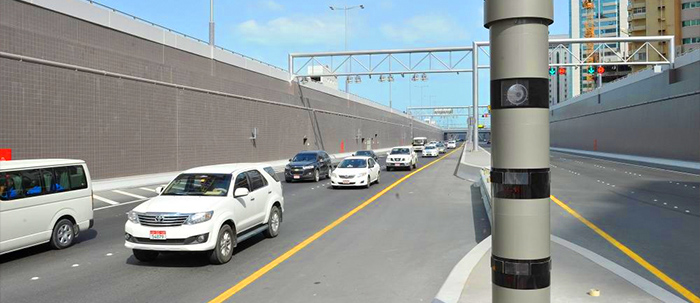 |
| A roadside sensor array |
In the field of road transport, ITS refer to systems in which information and communication technologies are applied in order to enhance the safety of road users and to improve the efficiency of traffic flow. This includes infrastructure, vehicles and users, and in traffic management and mobility management, as well as for interfaces with other modes of transport.
To improve road safety, advanced sensors are used as part of the road infrastructure to detect the presence of stalled cars and notify vehicles moving towards such locations as an early warning signal to avoid collisions. Sensors are also used to monitor adverse weather conditions that limit visibility in some road sections, such as fog; or affect road surface conditions, such as snow and ice. Determination of the precise boundaries of the affected areas enables the system to notify motorists selectively as they approach or enter these areas, thereby avoiding accidents. The detection of such hazardous road conditions enables also the use of signs with variable speed limits to slow down vehicular traffic when deemed necessary. They are also used as input to control adaptive street lighting to improve visibility under various weather conditions.
Sensors platforms are used in traffic management and enforcement for monitoring vehicles and pedestrian levels to optimize driving and walking routes. In order to estimate travel times accurately between origin and destination points on a road grid, sensor networks are used to collect information on the travel speed on each road sector, and the waiting times at all road intersection controlled by traffic lights or stop signs. Various sensor types and technologies can be used for this purpose. The data that are produced by the sensor network are used to guide motorists and law enforcement vehicles, as well as mobile emergency services to select the optimal travel routes and to prevent traffic congestion on certain road sectors to the extent possible. To enable the implementation of effective traffic management systems, it is essential that travel times be updated on a continuous basis, taking into account accidents or other factors that lead to traffic congestion on specific road sectors.
Research activities at the Center in the area of smart transportation systems focus on the following specific topics:
- The development and testing of sensors platforms for monitoring vehicle traffic levels and flow. The objective is to develop sensors platforms that are reliable, accurate and easy to install at low cost and hence affordable even in municipalities with limited economic resources;
- The development and testing of sensing technologies and platforms to detect and quantify climate conditions that affect visibility, such as fog and dust storms, and means for providing drivers with early notifications. Again, the emphasis of the research is on the development of affordable and effective sensors platforms for this purpose;
- The development of algorithms for determining the optimal routes in terms of the shortest travel times for motorists and law enforcement officers in metropolitan areas.

